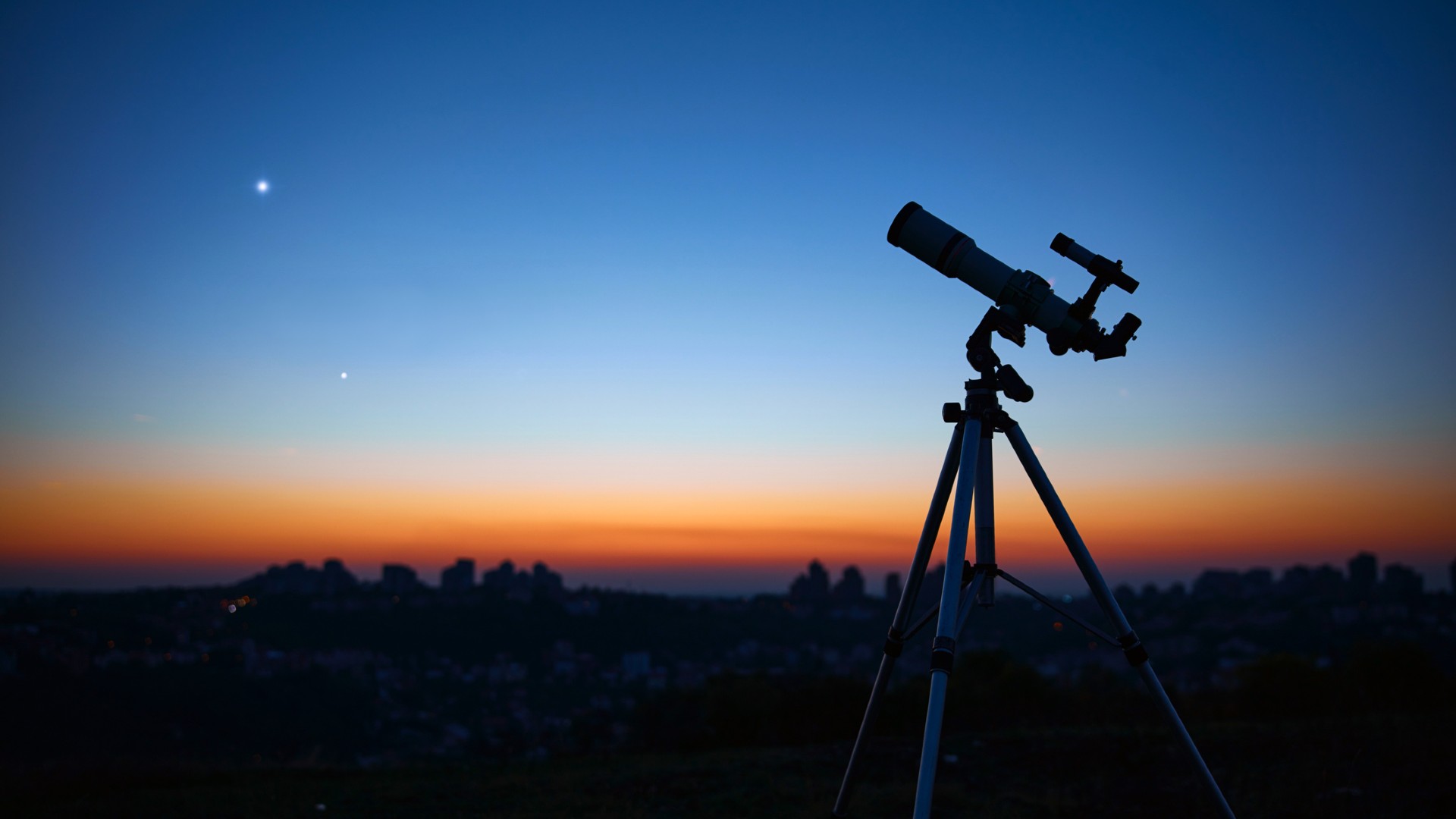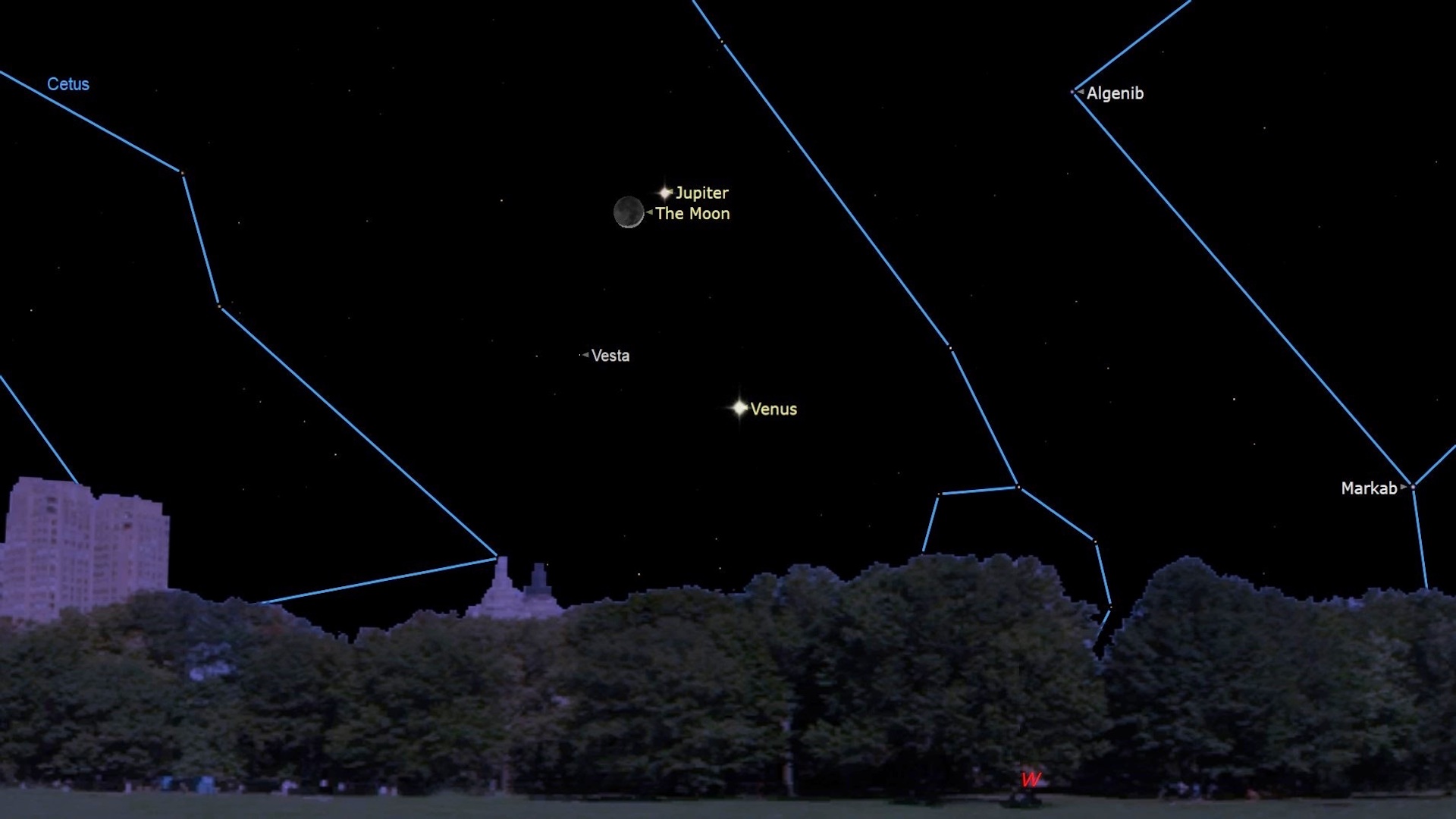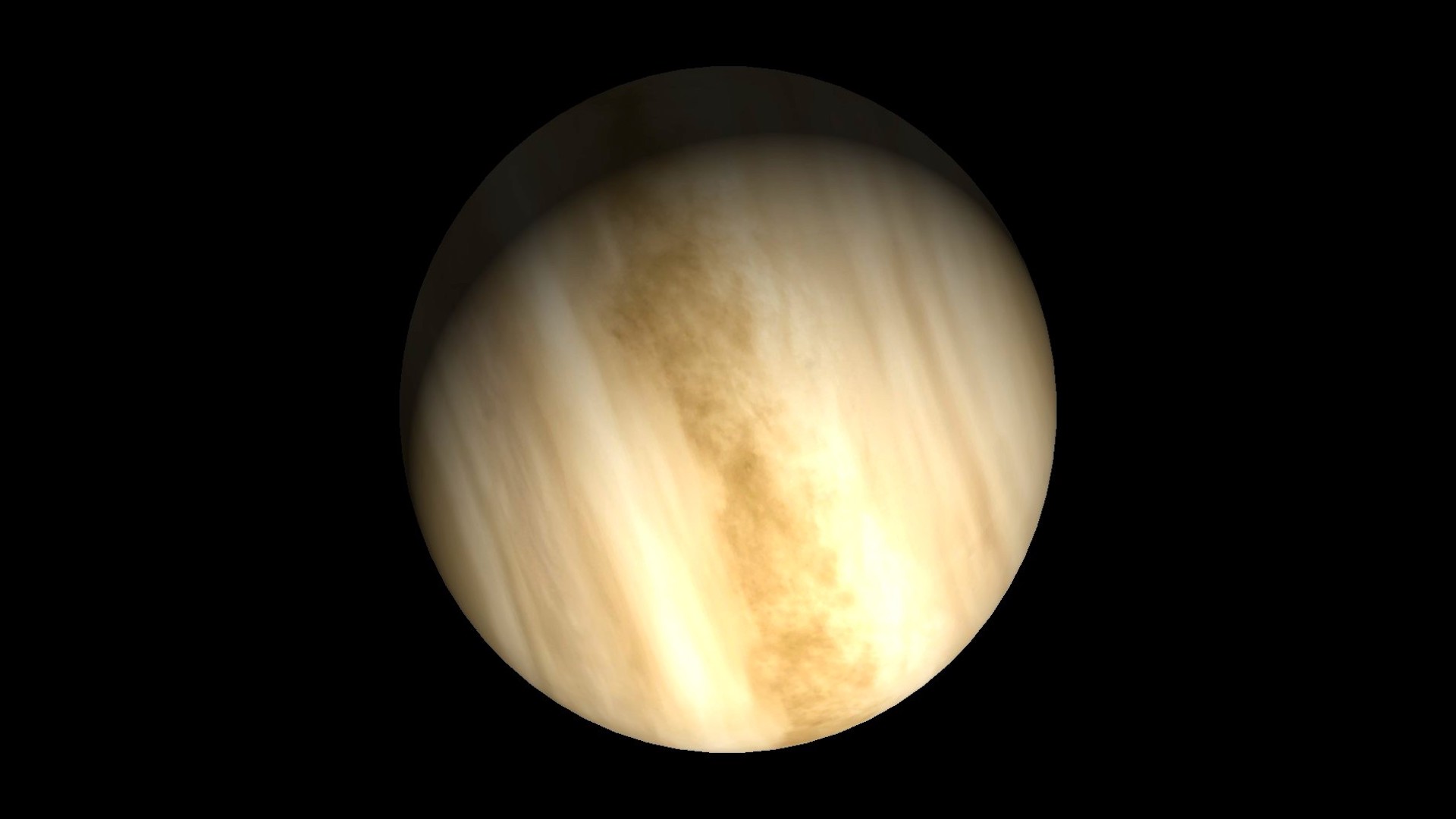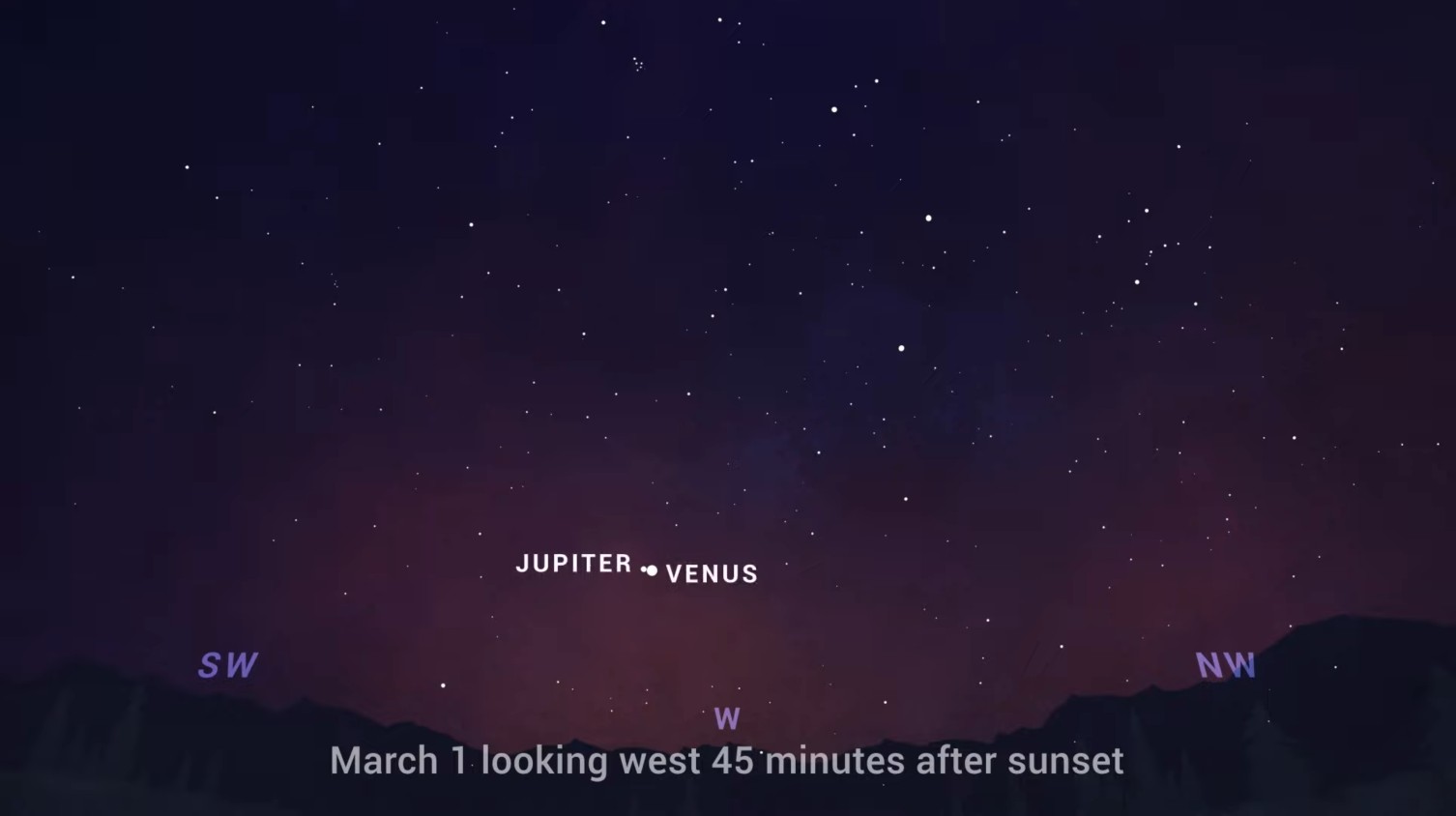
The celestial highlight of the month is actually a drama that has been building all through February.
The two brightest planets in our sky — Venus and Jupiter — have been slowly approaching each other. At the start of the month, they were separated by 29 degrees. From your outstretched hand, your clenched fist is equal to roughly 10 degrees, so at the beginning of February these two brilliant planets appeared roughly "three fists" apart. But ever since, they have been getting progressively closer to each other by an average of about one degree each evening.
On Presidents' Day, Monday Feb. 20, the distance between the two will have shrunk to just a little over nine degrees (or about "one fist"). A week later, on Feb. 27, the gap separating the planets will have diminished to just 2.3 degrees.
Finally, they will appear closest together on Wednesday evening, March 1, when they will be a scant 31 arc minutes (0.52-degrees) apart. Jupiter will shine at magnitude -2.1, twice as bright as Sirius, the brightest star in the sky. But Venus will be blazing at magnitude -4.0, nearly six times brighter than Jupiter! Weather permitting, these two worlds should make for a very striking visual spectacle, no doubt attracting the attention of even those who don't give more than a casual glance at the night sky.
Related: The brightest planets in February's night sky: How to see them (and when)
Read more: Night sky, February 2023: What you can see tonight [maps]
The moon joins in

Looking for a telescope to see the night sky up close? We recommend the Celestron Astro Fi 102 as the top pick in our best beginner's telescope guide.
As if having the two brightest planets calling our attention to them in this month's evening sky wasn't enough, the moon will add its own special luster to this array during the evenings of Feb. 21 and 22.
On Tuesday evening (Feb. 21), look low toward the west-southwest horizon approximately one hour after sunset and you will see the slender sliver of a waxing crescent moon — just 4% illuminated — hovering approximately 7 degrees below Venus. Jupiter will appear about 8 degrees above and to the left of Venus; so, they will appear along a long-crooked line, almost equally spaced apart from each other.
Get the Space.com Newsletter
Breaking space news, the latest updates on rocket launches, skywatching events and more!

The next night (Wednesday, Feb. 22), the moon will have widened a bit (10% illuminated) and will have also shifted its position from the previous night to a point 1.4-degrees to the lower left of Jupiter. The trio will now resemble a long, narrow triangle, pointing down in the general direction of the due west horizon.
Binoculars will greatly enhance the view, especially of the phenomenon known as Earthshine; the waxing crescent moon appearing as a thin arc of yellowish-white light enclosing a ghostly bluish-gray ball. Actually, for at least several nights, up to nearly a week after new moon, sunlight reflected from Earth illuminates the night side of the moon, making its whole disk visible. Here is one of nature's beautiful sights and fits the saying, "The old moon in the new moon's arms."
And keep in mind that you'll be seeing an arrangement of three celestial bodies at widely varying distances from our Earthly vantage point. The moon will be about 227,000 miles (365,000 km) away. Meanwhile, Venus is 131 million miles (210 million km) from Earth, while Jupiter is more than four times farther away at 530 million miles (853 million km).

How rare?
Conjunctions between Venus and Jupiter are far from being rare events. According to Jean Meeus, a highly regarded calculator of planetary motions, they occur at mean intervals of 13 months, more precisely: every 398.88 days.
But this is not quite correct, because every once in a while, a triple conjunction between these two planets will occur, with three conjunctions taking place over a time span of four months. For this to happen, Venus must be close to inferior conjunction (when it's positioned between us and the sun). It then appears to temporarily reverse its normal eastward path against the background stars, turning back toward the west. If Jupiter happens to be in the general vicinity, Venus will pass the largest planet while heading east, pass it again after it has turned back to the west and pass it yet a third and final time when it resumes its normal eastward course. The next three-time passing of Venus relative to Jupiter will happen during the spring and summer of 2036.

The 24-year Cycle
Interestingly, there is also a 24-year cycle for Venus-Jupiter conjunctions. Their sidereal revolution periods — "sidereal" referring to "with respect to the stars" are 224.7008 days for Venus, 365.2564 days for Earth, and 4332.5894 days for Jupiter. As it turns out, 39 revolutions of Venus are almost precisely equal to 24 revolutions of Earth and 2 revolutions for Jupiter. So, after 24 years (more precisely, 24.0175 years) the circumstances of a particular Venus-Jupiter conjunction will appear to repeat under almost identical conditions.
So, for instance:
| Date | Separation |
|---|---|
| Feb. 17, 1975 | 7-arc min (0.11°) |
| Feb. 23, 1999 | 8-arc min (0.13°) |
| March 1, 2023 | 31-arc min (0.52°) |
| March 8, 2047 | 53-arc min (0.88°) |
| March 14, 2071 | 80-arc min (1.33°) |
| March 21, 2095 | 110-arc min (1.83°) |
But such 24-year cycles cannot go on forever, mainly because Venus cannot stray more than 47-degrees from the sun. Eventually, the two planets must break off and go their separate ways. That's why by late May of 2239, the two planets will get no closer than 5-degrees from each other in the evening sky; Venus will not be able to travel far enough to the east of the sun in order to reach Jupiter.
As you can see from our table, Venus and Jupiter came closest to each other back in 1975 and are now separating with each passage of a new 24-year cycle. The March 1st conjunction will still be strikingly close, so if it is clear that night, be sure not to miss it.
Joe Rao serves as an instructor and guest lecturer at New York's Hayden Planetarium. He writes about astronomy for Natural History magazine, the Farmers' Almanac and other publications. Follow us on Twitter @Spacedotcom and on Facebook.
Join our Space Forums to keep talking space on the latest missions, night sky and more! And if you have a news tip, correction or comment, let us know at: community@space.com.

Joe Rao is Space.com's skywatching columnist, as well as a veteran meteorologist and eclipse chaser who also serves as an instructor and guest lecturer at New York's Hayden Planetarium. He writes about astronomy for Natural History magazine, Sky & Telescope and other publications. Joe is an 8-time Emmy-nominated meteorologist who served the Putnam Valley region of New York for over 21 years. You can find him on Twitter and YouTube tracking lunar and solar eclipses, meteor showers and more. To find out Joe's latest project, visit him on Twitter.
